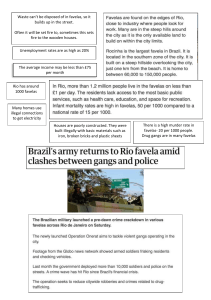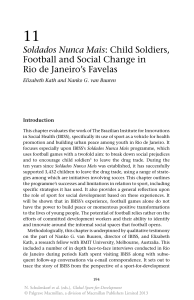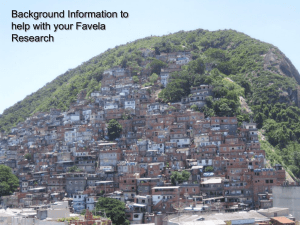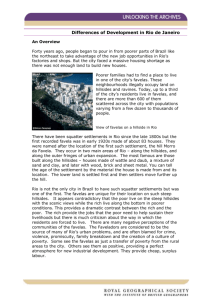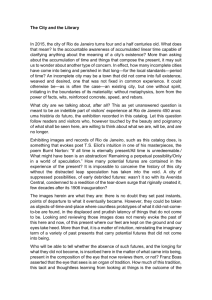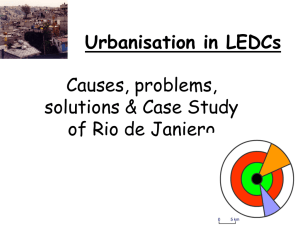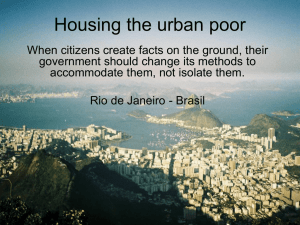Rio de Janeiro
advertisement
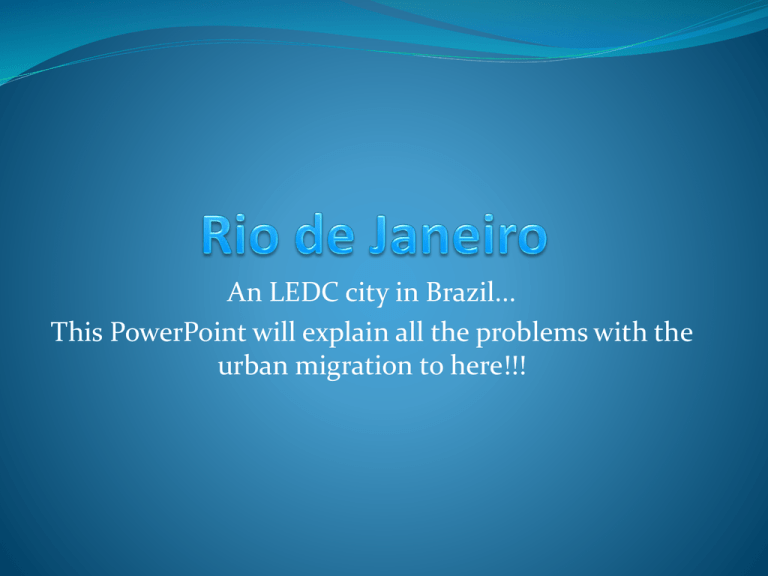
An LEDC city in Brazil... This PowerPoint will explain all the problems with the urban migration to here!!! So where is Rio de Janeiro? Rio de Janeiro is in the huge natural harbour of Guanabara Bay in the south east of Brazil It is one of the worlds mega cities It has a tropical savannah climate with an average annual temperature of 23oC. Rio de Janeiro is an LEDC city and it used to be the capital of Brazil... But now it’s been replaced by São Paulo So what’s the actual problem? More and more people are moving from the rural areas of Brazil to the urban areas of Rio de Janeiro in search of work, houses, fortune and a better quality of life. However this causes pressures on the area because there isn’t enough work, homes, wealth or facilities to take so many people. So Rio de Janeiro is left with the problems of an increasing population due to urban migration. People can’t afford to move out again so they just stay and the conditions get increasingly worse. People move to Rio de Janeiro due to various push and pull factors, for instance, there may have been floods or draught in their home town which mean they are unable to continue to survive there or they may simply be searching for work and a better quality of life. Impact on Age Structure I would guess there is a high proportion of the population in the younger years, because children are seen as an investment for the future and can be sent to work at a young age so provide another income, so more are born. The lack of education will also cause the birth rate to rise because of the lack of knowledge about things like contraception. I would also expect to see a skew towards more productive males in the city because males are more likely to migrate and leave their families in the home town and then they send money back home to them. There would also probably be a high number of 20-30 year olds as this age group would be most likely to migrate in search of a new life. Wealth They might be a bit poor.... There also may be a strong division between classes, for example along the beaches of Copacabana and Ipanema they is luxury housing that contrasts strongly to the huge shanty towns (favelas), such as Rocinha, that perch on the steep slopes of the mountains behind Rio de Janeiro. Employment Due to the lack of employment in Rio de Janeiro many people turn to informal work (like being a SHOE SHINER) but this means that they are not taxed and so the government is put at a disadvantage. Work in the informal sector provides jobs for over half of the city’s population. Housing 40% of the population lives in favelas or shanty towns such as Rocinha. Rocinha is a large shanty town to an estimated 150000 people, though it is likely to be more. It is built on steep land (too steep to build normal houses on) to the south of the city, it is unwanted land because of frequent landslides that often leave thousands of the favela inhabitants homeless as their improvised homes are washed away by the flash floods and mudslides that occur after rain events. Over 200 people died in a storm in 1998 due to the mudslides There are over 600 favelas, Rocinha being one of the largest, people in these towns have no legal right to the land they live on and could be evicted at any time Housing continued The houses are made of scrap materials such as wood, corrugated iron, broken bricks and tiles These shanty town homes have no facilities such and toilets, running water or cooking facilities The people often have to walk miles each day just to fetch clean water to drink and cook with There have been some efforts to evict these people and their homes have been destroyed, but they have nowhere else to go so simply return and rebuild after the immediate threat has passed. The local authorities now accept favelas and are trying to improve the living conditions in the shanty towns through Schemes such as the Self -Help Scheme’s or the Favela Bairro Project Health Partially due to cramped housing conditions especially in the favelas, in fact the population density is 329 people per square kilometre (which is very high), the health conditions are poor. There is easy spread for infectious diseases because everyone is all together The poor sanitation and lack of clean drinking water mean that there is a likelihood of outbreaks such as the cholera outbreak in Rocinha is 1992 However, recently there has been a lot of focus and investment in the health care and the average life expectancy has now risen to 72.59 years (in 2007) Pollution As Rio de Janeiro has factories that spill out fumes and pollute the surrounding area, and traffic congestion fumes, the sea, beaches, and coast line is often very polluted. This is the case with Guanabara Bay much of the time. There is also a huge problem with the amount of waste and rubbish that the large city creates. In favelas this rubbish is almost never collected and can pollute drinking water and create health hazards. There is a lot of traffic congestion in Rio de Janeiro this is partially because of the lack of routes in and out of the city, whilst the mountains look pretty and everything they work against the accessibility of the city and hem the city in. Services available Given the large population in Rio de Janeiro it is understandable that there are not enough services to provide for all of the population. - education services.... .???? Most of the people lacking in services are the people living in the favelas. They lack even the basic services such as a sewage disposal or rubbish collections, in fact, in some favelas there are open sewage pipes running through the town. Due to the lack of services around for people there is an increase in crime because, especially amongst the unemployed, they have nothing else to do and need to resort to crimes Crime Crime is a huge problem in Rio de Janiero, especially in the shanty towns due to poor street lighting and the lack of wealth of the people. They find it necessary to steal simply to make ends meet and afford the essentials of life, such as food. Tourists going to the larger beaches such as Copacabana and Ipanema are told not to bring valuables due to the risk of pickpockets. The well-off residents of Rio are leaving as fast as they can so that they can et away from the crime rates and to safer environments. The favelas are often associated with organised crime, violence and drug trafficking Residents argue otherwise and claim that crime is not a significant problem and community spirit is very strong. So in conclusion... Whilst the conditions of the overcrowding in Rio de Janeiro due to rural-urban migration are improving they are still rather low and have a long way to go. One of the solutions was to create more cities, but this simply moved the problem of overcrowding and favelas round the country more and only relived the pressure very slightly.
